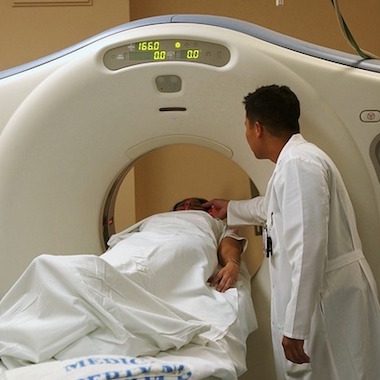
Few things can stop you in your tracks like low back pain. The smallest movement can cause pain that takes your breath away. And it can be very frightening. Low back pain results in more than two million visits to the emergency room every year. Millions of dollars are spent on diagnostic tests that evidence suggests may not be all they are cracked up to be.
Nearly half of all patients seen in the emergency room for back pain are given a diagnostic test like an X-Ray, MRI or CT scan. The intensity of low back pain, for many people, is alarming and imaging tests feel imperative. If your foot hurt like that, you might think, an X-ray might show a fracture, which could then be set and casted—boom problem solved.
Unfortunately, low back pain can be much less straight-forward and imaging may not lead to a good fix. It’s not that these tests can’t pick up problems in the spine, in fact, they pick up lots of them. According to a 2015 review, the issue is that often these problems have nothing to do with the pain.
Researchers looked at CT and MRI findings for more than 3,000 asymptomatic men and women and found degeneration typically associated with back pain. And, the older the patient, the worse their spine looked. A disc bulge was present in 30% of 20-year-olds and 84% of 80-year-olds. Remember this was a review of people who had NO complaints of back pain.
Finding a disc bulge or degeneration on an image can’t always mean, then, that it is the source of your pain. In fact, some argue that just getting these diagnoses can make you feel worse. You come in with back pain and you leave labeled with a scary-sounding medical problem.
That is not to say, that pain in the low back is never serious. It can be a sign of a number of grave conditions like spinal fracture, cancer or infection that can be confirmed by X-ray, CT or MRI. However, these problems don’t happen frequently, and they often come with other red flags.
The presence of red flags increases the likelihood of a serious problem that may require emergency treatment, hospitalization and even surgery.
Red Flags
- Numbness
- Loss of power in the legs
- Bowel/Bladder changes
- Difficulty walking
- History of Cancer or osteoporosis
- Fever
- Unexplained weight loss
- Pain that wakes you up in the night
- History of HIV or IV drug use
When these red flags are present imaging can be a powerful life-saver. Most cases of low back pain don’t come with red flags, however. According to the American Academy of Family Physicians, “Most people with lower-back pain feel better in about a month, whether or not they have an imaging test.”
And if diagnostic imaging isn’t necessarily going to help, you have to ask the question, “Can it hurt?”
The answer is yes, to some degree. Tests can be expensive, some expose you to radiation, and there is some amount of hassle in getting them. Research also suggests that the tests themselves can result in the perception of increased disability and pain. And, of course, there is always a risk that test findings could result in unnecessary or ineffective treatment—including surgery.
As with all medical decisions, whether or not to have an X-ray, MRI or CT scan comes down to weighing the harms against the benefits. And the good news is you are not alone in this. If you are suffering from low back pain talk to your doctor about what is best for you.
Image credit: © milazvereva /Pixabay

